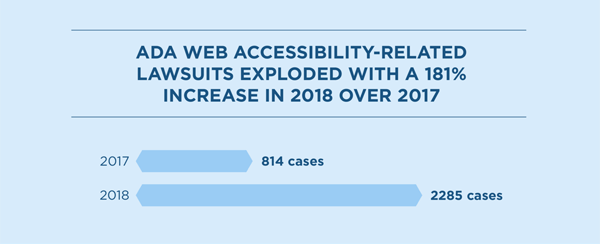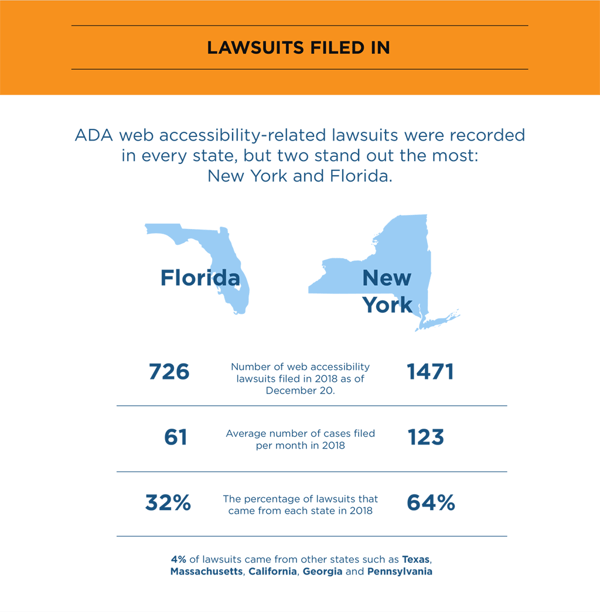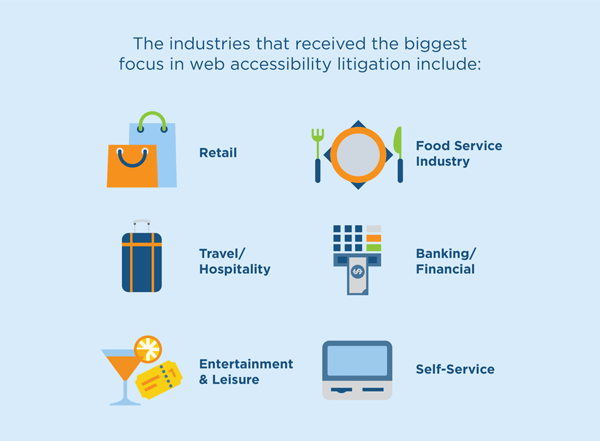Editor's Note: See last month's ADA lawsuit numbers with UsableNet's lawsuit tracker.
This blog is based on our 2018 lawsuit report, which we compile twice a year. To view the latest numbers, check out our 2024 Midyear report on digital accessibility lawsuits.
Our latest year-end numbers are here in the 2023 year-end report.
The lawsuit culture surrounding website accessibility has grown steadily over the past few years and shows no slowing. UsableNet’s research team has tracked all ADA web accessibility-related lawsuits throughout 2018.
They affect companies large and small in a wide range of industries in communities at home and abroad. The industry's insufficient progress toward accessibility and unclear government guidance has only contributed to the problem.
The 2018 web accessibility lawsuit report
The UsableNet research team has been tracking 2018 federally filed ADA web accessibility-related lawsuits. In 2018, we tracked 2285 lawsuits—up 181% over 2017 which had 814.
Image description: ADA web accessibility-related lawsuits exploded with a 181% increase in 2018 over 2017.
In 2017, there were 814 cases. In 2018, we tracked 2285 lawsuits filed.
New York- and Florida-Based Plaintiffs
New York and Florida are still where the majority of lawsuits are brought, but this reflects more about the plaintiffs and their lawyers’ locations and less about the companies being targeted. Any company that does business in these states can be targeted. New York and Florida represent 96 percent of total filings, but the key point here is that only the filings are in these two states; the companies listed are from all over.
Image description: A graphic communicates that in Florida, 726 lawsuits were filed in 2018 resulting in an average of 61 lawsuits filed per month. Out of all 2018 lawsuits, Florida was responsible for 32%. New York was accountable for 64% of all 2018 lawsuits.
The Effect Is Nationwide and International
Taking a look at the headquarters locations of the companies that are listed in the New York and Florida filings, it’s clear that the whole nation is affected. The top ten states are New York, California, Florida, Texas, Pennsylvania, Ohio, New Jersey, Massachusetts, Georgia, and Connecticut. Also, 11 percent of the cases involve non-US-based companies, so the effect is global.
Image description: The companies sued in these jurisdictions are distributed across the US.
The companies sued in these jurisdictions are distributed across the US.
There Is an Industry Pattern
Although many industries are involved across the cases, six stand out for the additional attention they get. Retail, food service, travel/hospitality, banking/financial, entertainment and leisure, and self-service, have the majority of cases, reflecting a general pattern over 2017 and 2018 toward these types of organizations.
Image description: The industries that received the biggest focus in web accessibility litigation include retail, food service, travel/hospitality, banking/financial, entertainment and leisure and self-service
Defending Lawyers vs. Plaintiff Lawyers
With more than 600 law firms representing companies across the U.S., the top 10 law firms represent over one-third of all cases on the defendant side, while the top 10 plaintiff firms bring over three-fourths of all cases. The report lists the top 10 on each side of the fence squaring off on a regular basis that will likely mean similar settlements and agreements being agreed over time.
Image Description: A visual of a justice scale represents the percentages that each group defends.
Summary
Lawsuits at a federal level (covered in the report) continue to rise for two primary reasons.
Firstly, companies have not been proactive enough in both action and communication of digital accessibility, especially as people with disabilities rely more and more on them.
Secondly, the DOJ’s lack of a clear standard leaves lots of room for interpretation and allows even companies that have been proactive to be targeted.
Without action from the DOJ in 2019, which does not look likely, the most effective use of resources for any company is to immediately understand where it stands with regard to web accessibility and the popular standard of the WCAG; create a plan to remediate any barriers to people using assistive technology; and engage a third party to communicate and document the efforts. These three activities should help reduce the likelihood of a company being identified by plaintiffs and their lawyers.












